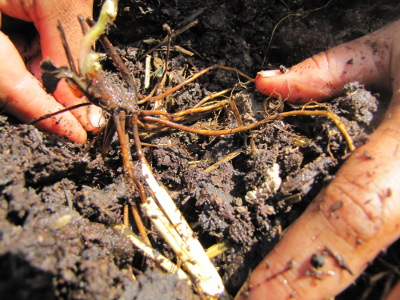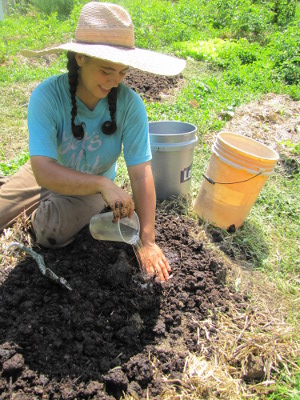
New strawberry plants
 It feels almost ungrateful to
rip strawberry plants out of the ground mere days after they gave me
gallons of fruits, but that's what I was doing last week. We pull
out the oldest plants (a third to half of our beds) at this time of
year and put in new beds of rooted runners. Some of these
summer-planted strawberries succumb to the heat, but the ones that make
it are hefty enough to bear a good (but not great) crop of fruits the
next year. These are the tastiest
berries that I
reserve for eating fresh, while the more copious fruits from the two
year old
It feels almost ungrateful to
rip strawberry plants out of the ground mere days after they gave me
gallons of fruits, but that's what I was doing last week. We pull
out the oldest plants (a third to half of our beds) at this time of
year and put in new beds of rooted runners. Some of these
summer-planted strawberries succumb to the heat, but the ones that make
it are hefty enough to bear a good (but not great) crop of fruits the
next year. These are the tastiest
berries that I
reserve for eating fresh, while the more copious fruits from the two
year old  plants are used to make strawberry
shortcake, strawberry freezer jam, or strawberry
leather.
plants are used to make strawberry
shortcake, strawberry freezer jam, or strawberry
leather.
I've just about gotten
used to ripping out happy strawberry plants, but the strawberry
demolition this year was even more serious. I opted to remove all
of our latest bearing variety (Jewel) and replace them with a new
variety that I hope will taste better (All-Star.) The mail order
strawberries came in a very dormant state, so I hope they're able to
deal with the summer garden.
Any angst I felt about
pulling out such stalwart garden friends was relieved by the sheer joy
the chickens took from picking through the plants in search of rotten
berries. At least someone enjoys those not-so-great Jewel
strawberries!
Want more in-depth information? Browse through our books.
Or explore more posts by date or by subject.
About us: Anna Hess and Mark Hamilton spent over a decade living self-sufficiently in the mountains of Virginia before moving north to start over from scratch in the foothills of Ohio. They've experimented with permaculture, no-till gardening, trailersteading, home-based microbusinesses and much more, writing about their adventures in both blogs and books.
Want to be notified when new comments are posted on this page? Click on the RSS button after you add a comment to subscribe to the comment feed, or simply check the box beside "email replies to me" while writing your comment.

Dave --- When setting out plants like this, I mulch right away, but make sure the mulch won't blow on top of the developing plants. (Depending on what I'm mulching with, that might mean giving the plant several inches of bare ground around it and pulling the mulch in later.) I put the straw down as thick as feels right to keep the weeds away --- generally 1/6 to 1/3 of a bale per garden bed (roughly 20 square feet). If you let the straw sit out for a few weeks beforehand, you use more straw, but can mulch right up against the plants since you don't have to worry about it moving around.
Good luck with your new berries!